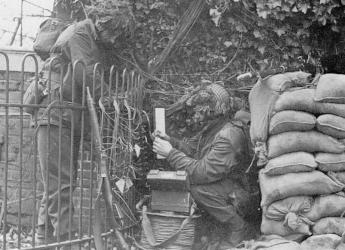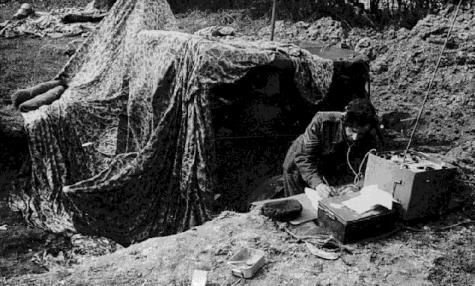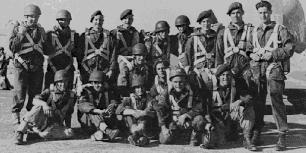Palestine 1945-1948
On 2 November 1917, the British Government had promised to allow the Jews to establish a 'Jewish National Home' in Palestine, but recognized that Arab rights must be safeguarded. This promise was embodied in the Balfour Declaration of 1917 and a Mandate by the Council of the League of Nations in July 1922 made Britain responsible for creating conditions in Palestine which would ultimately lead to this objective. The period of the Mandate was marked continually by conflict between Arab and Jew and at the end of the War the Arabs did not hesitate to resurrect the conflict.
It fell to 6th Airborne Division, in its new post-war role as Imperial Strategic Reserve, to be tasked with policing the Mandate in Palestine. Within four months of leaving Wismar in the Baltic, 6th Airborne Division found themselves deployed to the Middle East.
2nd Parachute Brigade regrouped with 6th Airborne Division on 3 September 1945 to replace 5th Parachute Brigade who were still deployed in Java. 2nd Parachute Brigade, however, did not join 6th Airborne Division in Palestine until October. On 15 September, Division HQ main body and various unit advance parties left for Palestine. Ten days later 6th Airborne Divisional Signals main body arrived at Haifa having sailed from Southampton aboard HMT Dunera. The Unit moved from Haifa by rail and road to Nuseirat Hospital Camp near the town of Gaza. A Divisional Signal Office was established in Nuseirat by the morning of 26 September and Tac Division HQ was established the next day. The stay in Nuseirat was, however, short. Division HQ and Divisional Signals moved to the Sarafand area near Tel Aviv. The Unit occupied a camp at Bir Salim some two miles from Sarafand which was affectionately nicknamed 'Beacon Barracks'. The Main Division Signal Office opened at Bir Salim on 20 October 1945. Communications which the Unit included line, Division wireless nets, and links to HQ Palestine in Jerusalem and to 1st Infantry Division in Haifa.
At first, life in Palestine was reasonably peaceful and reinforcements continued to arrive from 1st Airborne Divisional Signals who were by now in the final stages of disbanding. The tranquillity soon came to an end when rioting broke out in Tel Aviv in November 1945. At the time, the Division's deployment included 3rd Parachute Brigade in Tel Aviv and 6th Airlanding Brigade in the surrounds to the town. 2nd Parachute Brigade were responsible for the remainder of southern Palestine.
Early in the New Year 1946, 283 Wing RAF joined 6th Airborne Division and a new Joint Headquarters was established at Qastina Camp. The accommodation was tented although buildings were available for offices and messes. The Divisional Signal Office opened at Qastina on 29 January. In the next few months a considerable amount of terrorist activity became directed at the British Administration and at military targets. A jeep belonging to the Unit was attacked by a mob in Tel Aviv on 17 February and the occupants injured.
It was during this period in 1946 that Signal units throughout Royal Signals became designated 'Regiment', 'Squadron' and 'Troop'. This arrangement replaced the vague 'Signals', Company and Section in use since the Corps formed in 1920. Thus 6th Airborne Divisional Signals changed its title to 6th Airborne Divisional Signal Regiment and Brigade Sections were retitled as Troops. Companies within the regiment became Squadrons.

Plate 19. Linemen of 5th Parachute Brigade Signal Section in Heldon, Holland 3 February 1945
Click to enlarge the picture.
Also in 1946, Royal Signals changed the design of the cap badge. The 'Lifebelt' badge was replaced by the design still worn to this day. The figure of Mercury holding a Caduceus was at this time surmounted by the Imperial Crown. It was not unti1 1953 that the Imperial Crown was replaced by the Crown of St Edward following the accession of HM Queen Elizabeth II. Royal Signals officers had however always worn the embroidered figure of Mercury.
It was also in the Spring of 1946 that 6th Airborne Division reorganised into a three parachute brigade division. 1st Parachute Brigade who had returned to England in the late Summer of 1945 from their post YE Day role in Denmark, arrived at Port Said in HMT Orontes on 1 Apri11946. The Signal Section, which had been formed in the main from 1st Airborne Divisional Signals, moved with the rest of the Brigade to Camp 21 near Nathanya over the next week. 6th Airlanding Brigade which had been with the Division from the start, moved to Jerusalem on 29 and 30 March. On 15 April 6th Airlanding Brigade re-roled and became 31st Independent Infantry Brigade. The Brigade wore the red beret for the last time at a farewell parade in Jerusalem on 26 April 1946. The Brigade remained in Palestine until it disbanded in November.
In July 1946 a major IS operation (Operation AGATHA) was undertaken which involved virtually the whole Division in a cordon and search of Tel Aviv. The Signal Regiment was involved in providing communications and in actively disrupting civilian communications in various towns in southern Palestine. This disruption was achieved by the Light Line Troop occupying certain civil telephone exchanges and disrupting circuits. On 30 July a second and similar operation (Operation SHARK) was carried out. On this operation, Division HQ established itself at Jaffa Police Station.
Airborne training was beginning to suffer because of the heavy commitment on IS duties and because of the limited parachute training facilities. Recruiting at this time was not particularly good in spite of a special recruiting team in UK. An Airborne Troop had already been established at Pocklington as part of the Depot, Royal Signals. However, the manning situation was slightly eased as reinforcements arrived from 5th Parachute Brigade when it disbanded in the Far East.
Lieutenant Colonel D A Pringle, who had previously been Commanding the Indian Airborne Divisional Signals, took over command of the unit from Lieutenant Colonel Bradley in December 1946. Also towards the end of 1946, it had been hoped that 6th Airborne Division would leave Palestine and go to Germany as part of the British Army of the Rhine. That hope never materialised and it was decided that only one brigade would leave more or less straightaway. 2nd Parachute Brigade was chosen and December was spent preparing the Brigade for departure. The Signal Troop was made fully up to strength from the Regiment before leaving Palestine.
In the New Year 1947, the Division moved north to Haifa to relieve 1st Infantry Division. The Regiment again set up a 'Beacon Barracks' at Stella Maris Camp on Mount Carmel. Division HQ and its Signal Office established themselves in the monastery and lighthouse on the Mount. The Signals Regiment occupied a hutted camp in the vicinity of the monastery and the whole complex was surrounded by a barbed wire fence. 1st Parachute Brigade were located at Nazareth and 3rd Parachute Brigade at Haifa. The Regiment not only provided the normal divisional communications but was also communications for those involved in stopping ships trying to land illegal immigrants. The immigrants, if caught, were deported to camps in Cyprus and this procedure increased the level of hostility between the Army and the Zionists. Arab-Jewish incidents were also on the increase and the Army suffered a number of casualties. A truck belonging to 6th Airborne Divisional Signal Regiment was blown up near Hadera on 2 March 1947 by an electrically detonated mine which wounded two soldiers. Within the space of a few days one Signalman was killed in Haifa, one DR ambushed and wounded and two Sergeants and two Signalmen were wounded when the CairoHaifa express was mined and derailed. On 15 July an attempt was made by a Palmach commando unit to destroy the RAF radar on the very top of Mount Carmel.
2nd Parachute Brigade Signal Troop had already left Palestine in January 1947 and returned to Perham Down near Tidworth. The Brigade thereby achieved independence from 6th Airborne Division. In May 1947, Major G Proudman, who had been commanding No 2 Squadron in the Divisional Signal Regiment, returned to England to take over 2nd Parachute Brigade Signal Troop and reform it into an independent squadron. Notes covering the unit's activities are under 2nd Independent Parachute Brigade Signal Squadron.
In January 1948 news was received in Palestine that the remainder of 6th Airborne Division was now about to be returned to England before being deployed to Germany. However, this joyous bit of news was too good to be true. In February it was announced that the Division would return to England but instead was to be reduced to a Brigade sized formation.
On 2 Apri11948, HQ 6th Airborne Division closed in Palestine and passed control to HQ GOC North Sector. The Regiment embarked at Haifa on 13 April aboard HMT 'Otranto' and disembarked, in spite of a dock strike, at Southampton on 28 April and the next day moved by rail to 'Kangaroo Corner' Perham Down (so called because of its association with Australian troops during the War).
On 15 May 1948 the British Mandate in Palestine ended.

Plate 20. Wireless Operator, 6th Airborne Divisional Signals 24 March 1945
Click to enlarge the picture.
Reduction to a Brigade 1948
2nd Independent Parachute Brigade Signal Squadron had already moved to Germany in February 1948. It was subsequently decided that 2nd Independent Parachute Brigade would be retained in the order of battle when 6th Airborne Division was reduced.
On return to England, the Regiment set about the preparations for closing down. Reinforcements were sent to the Brigade Signal Squadron in Schleswig whilst others left the Army. Some members found their way into 16th Airborne Divisional Signal Regiment (Middlesex Yeomanry) TA.
A farewell parade was held at Perham Down on 25 June 1948 to mark the close of 6th Airborne Divisional Signal Regiment. The salute at the parade was taken by General Sir H Colville B Wemyss, Colonel Commandant. The Corps Band was also present. It was at this parade that the Warrant Officers and Sergeants of the Regiment presented a Silver Pegasus to the Warrant Officers and Sergeants of the remaining Parachute Brigade Group Signal Squadron. This Pegasus has been handed down by each unit since 1948 and is proudly displayed to this day in the Sergeants' Mess. A similar Pegasus was presented also at this parade by the Officers of the Regiment to the Officers, Royal Signals and is on display in the Headquarters Mess at Blandford.
On 30 August 1948 the Commanding Officer and Adjutant burnt the remaining files and sent the completed disbandment order to the War Office. So ended the life of a Regiment which had been in existence for just over five very eventful years.

Plate 21. A 'stick' from 6th Airborne Divisional Signal Regiment 1947
Click to enlarge the picture.